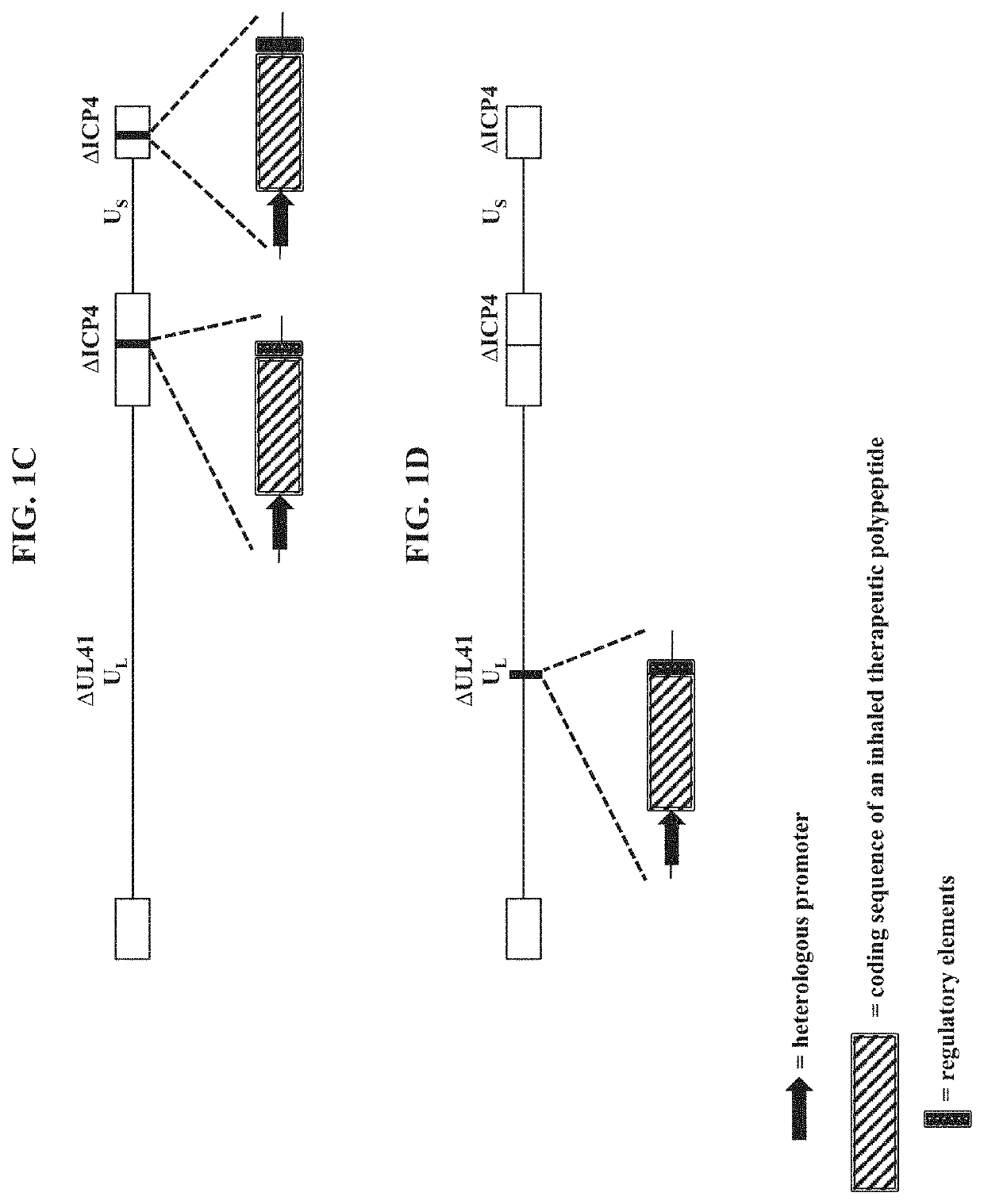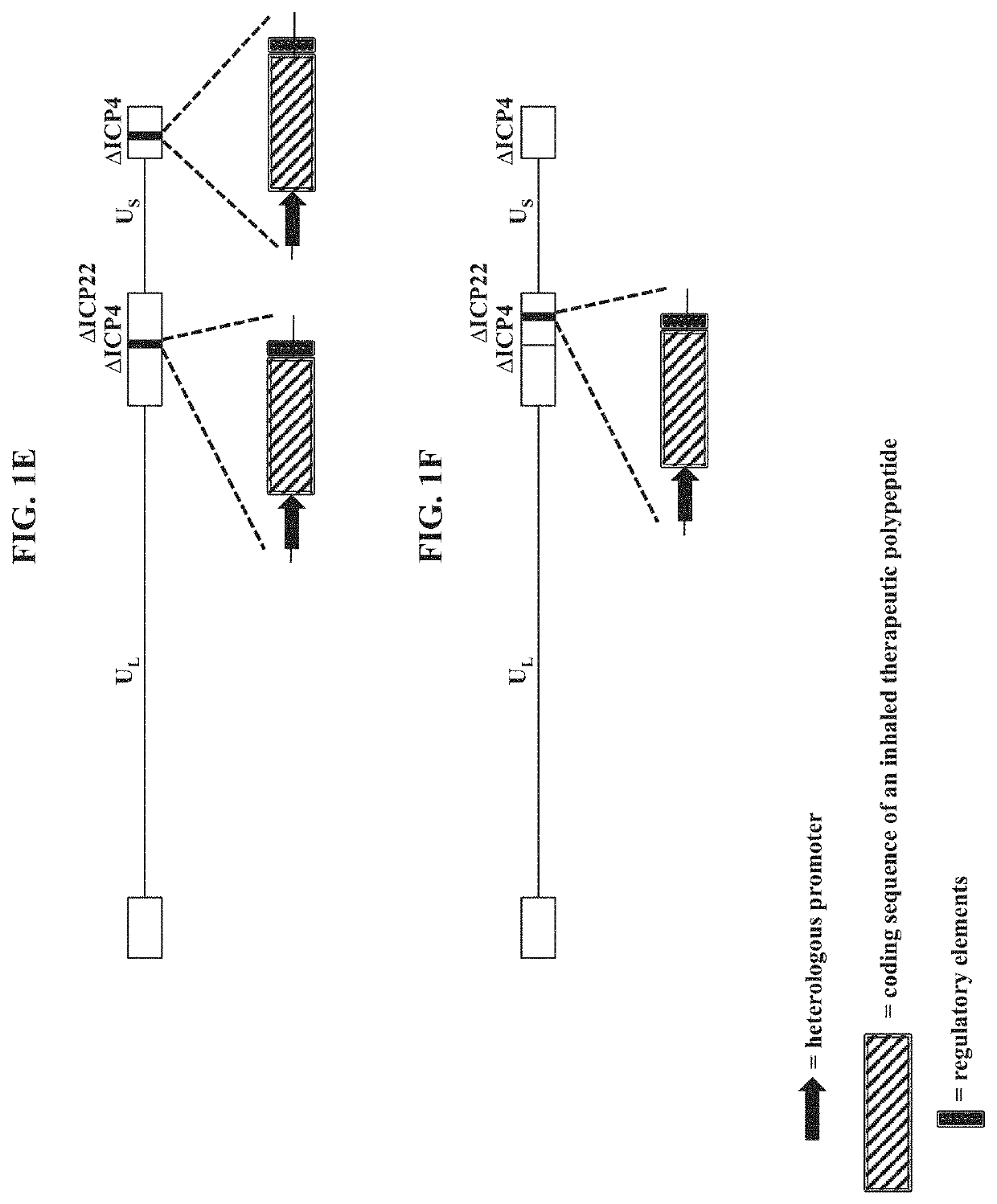Compositions and methods for gene delivery to the airways and/or lungs
a technology of compositions and methods, applied in the direction of drug compositions, peptide/protein ingredients, dsdna viruses, etc., can solve the problems of significant lifelong morbidity and mortality, lack of definitive treatment options for these patients, and congenital causes of respiratory diseases are often lethal. , to achieve the effect of reducing cytotoxicity
- Summary
- Abstract
- Description
- Claims
- Application Information
AI Technical Summary
Benefits of technology
Problems solved by technology
Method used
Image
Examples
example 1
Modified Herpes Simplex Virus Vectors Encoding an Inhaled Therapeutic Polypeptide
[0251]To make modified herpes simplex virus genome vectors capable of expressing inhaled therapeutic polypeptides in a target mammalian cell (such as cells of the respiratory tract), a herpes simplex virus genome (FIG. 1A) is first modified to inactivate one or more herpes simplex virus genes. Such modifications may decrease the toxicity of the genome in mammalian cells. Next, variants of these modified / attenuated recombinant viral constructs are generated such that they carry one or more polynucleotides encoding the desired inhaled therapeutic polypeptide. These variants include: 1) a recombinant ΔICP4-modified HSV-1 genome comprising expression cassettes containing the coding sequence of an inhaled therapeutic polypeptide (e.g., SEQ ID NO: 3) under the control of a heterologous promoter integrated at each ICP4 locus (FIG. 1B); 2) a recombinant ΔICP4 / ΔUL41-modified HSV-1 genome comprising expression ca...
example 2
In Vivo Administration of a Modified Herpes Simplex Virus Vector to the Airways of Wild-Type and Mutant Animals
[0253]An in vivo experiment was conducted in eight C57BL / 6 mice (“wild-type”) and four gut-corrected CFTR-deficient Cftrtm1UncTg(FABPCFTR)1 Jaw / J mice (“CFTR− / −”) to determine whether a modified herpes simplex virus vector (“HSV-CFTR”, an engineered HSV-1 encoding human CFTR) was both amendable to non-invasive inhaled administration and capable of transducing tissues throughout the airways of dosed animals. Four wild-type and four CFTR− / − mice were administered HSV-CFTR in parallel using a clinically approved nebulizer. Four wild-type mice were separately dosed with vehicle control using this same inhalation apparatus. Cage-side and clinical observations performed throughout the experiment identified no differences between HSV-CFTR and vehicle treated animals. No differences in bodyweights were noted between groups. 48 hours after nebulization, animals were euthanized, and ...
example 3
In Vivo Tolerability and Biodistribution of Repeat-Dose Modified Herpes Simplex Virus Vector in a Non-Human Primate
[0257]The objective of this study was, in part, to assess delivery of a modified herpes simplex virus vector in non-human primates (NHPs) after nebulization. This study was conducted, in part, to ensure repeated delivery of a modified herpes simplex virus vector was feasible for future inhalation studies. A single male cynomolgus monkey received a total of three exposures (vehicle (Day 1), low-dose HSV-CFTR (Day 5), and high-dose HSV-CFTR (Day 17)) followed by euthanasia and tissue collection (FIG. 5). The collected tissues included brain, spleen, kidney, liver, lung (three unique locations), heart, and lymph nodes (axillary and inguinal). Blood was also harvested pre- and post-administration to determine the systemic exposure to the drug product after inhaled application. All procedures conducted were in compliance with applicable animal welfare acts and were approved ...
PUM
| Property | Measurement | Unit |
|---|---|---|
| Fraction | aaaaa | aaaaa |
| Fraction | aaaaa | aaaaa |
| Fraction | aaaaa | aaaaa |
Abstract
Description
Claims
Application Information
 Login to View More
Login to View More - R&D
- Intellectual Property
- Life Sciences
- Materials
- Tech Scout
- Unparalleled Data Quality
- Higher Quality Content
- 60% Fewer Hallucinations
Browse by: Latest US Patents, China's latest patents, Technical Efficacy Thesaurus, Application Domain, Technology Topic, Popular Technical Reports.
© 2025 PatSnap. All rights reserved.Legal|Privacy policy|Modern Slavery Act Transparency Statement|Sitemap|About US| Contact US: help@patsnap.com



